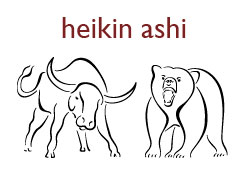When you initially discover forex trading charts, you’ll see candlesticks as the default setting on various timeframes. Candlesticks are classed as the gold standard of price display when you trade markets.
When you trade FX, you need a method to illustrate what price is doing, has done and where it might be headed, and it would be best to have a visual explanation of why a security’s price has moved in specific ways.
However, some novice traders struggle to decipher the language of candlestick trading. It can take months or several years to become competent at cracking the candlestick-trading code and applying the interpretation to your decision making.
Using candlesticks to identify price action
When you attempt to interpret the various candlestick patterns, you’re looking to identify what we refer to as “price action”. Trading price action isn’t the mysterious art many novice retail traders think it is. In its most basic form, it’s simple to implement.
You begin by observing easy to spot single candles on some of the higher time frames (TFs), such as 1hr, 4hr and the daily TF. These could be Dojis, spinning-tops, abandoned babies, morning/evening stars, hammers, hanging men etc. Then you move on to looking for and interpreting the various patterns that clusters of candlesticks make; three green soldiers, bearish and bullish engulfing, sandwiches, dark cloud cover, piercing lines etc.
Many mentors and experienced traders have reached a trading level whereby they only use candlestick patterns and the price action which develops to make their trading decisions. They’ll trade off vanilla charts with no moving averages and no other technical indicators. This skill level can take years to reach, but you have alternatives, and candlesticks aren’t the only visual method to identify price action.
Candlesticks are not the only visual representation of price
There are other methods available to illustrate price-action that can provide just as much feedback as candlesticks. You could use a simple line on your chart to show price, and you could use other representations such as Renko blocks. Some traders find these straightforward forms of displaying price easier to interpret than candlesticks.
You could also choose Heikin Ashi (HA) bars which many intermediate-level traders turn to as it provides an excellent springboard to begin developing your price-action skills.
Why Heikin Ashi can be the ideal choice for novice and intermediate level traders
In specific and limited ways, HA bars are like standard candlesticks. You look for closed bars, tails/shadows, Dojis etc. and clusters to indicate change or the continuation of the current momentum. HA also provides the perfect introduction to standard candlesticks, because you become proficient at translating the information in a similar way to interpreting candlestick movements.
The basics of Heikin Ashi and the Heikin Ashi Formula
Standard candlestick charts comprise a series of open-high-low-close (OHLC) candles. Heikin Ashi means “average bar” in Japanese, and the Heikin Ashi technique uses a modified formula of close-open-high-low (COHL).
You can master the basics of HA use quickly, and you’ll soon discover more clarity when trying to identify price-action. HA bars are more definitive and take on a more objective appearance. In contrast, standard candlesticks can be more subjective and open to alternative interpretations.
You’ll also note that you’re able to make more joined-up decisions when you engage in multi-timeframe analysis using HA. If you look for instructions from the 1hr, 4hr and daily charts, you’ll see clear links that aren’t always visible when you use standard candlesticks.
Putting Heikin Ashi to use
Five main signals help you to identify trends and trading opportunities with HA.
- Hollow or green candles without lower shadows can indicate strong uptrends
- Hollow or green candles can indicate uptrends, you could consider adding to long positions while exiting short positions.
- Candles with small bodies engulfed by upper and lower shadows might be indicative of a trend change. Traders might consider going long or short, while others might wait for further confirmation.
- Filled or red candles indicate a downtrend, you might want to add to your short position and exit any long positions.
- Filled or red candles without higher shadows can identify strong downtrends, and traders often stay short until there’s an identifiable change in trend.


